Dissertation on Impact of Organisational Culture on Eskom Performance
VerifiedAdded on 2023/06/12
|60
|15841
|105
Thesis and Dissertation
AI Summary
This dissertation investigates the impact of organizational culture on organizational performance within Eskom, a South African electricity company. The study aims to identify elements of organizational culture and their influence on performance, addressing gaps in the company's culture and providing recommendations for improvement. Using a survey strategy, data was collected from employees and analyzed using MS-Excel to determine the relationship between organizational culture and employee performance. The analysis revealed that individual factors did not significantly impact employee performance based on organizational culture, but overall, employees believed that Eskom's culture positively affects their performance. The study concludes by recommending strategies to enhance internal business procedures and customer services to gain a competitive advantage, emphasizing the importance of aligning organizational culture with the company's goals and mission. Desklib offers access to this dissertation and a wealth of study resources for students.
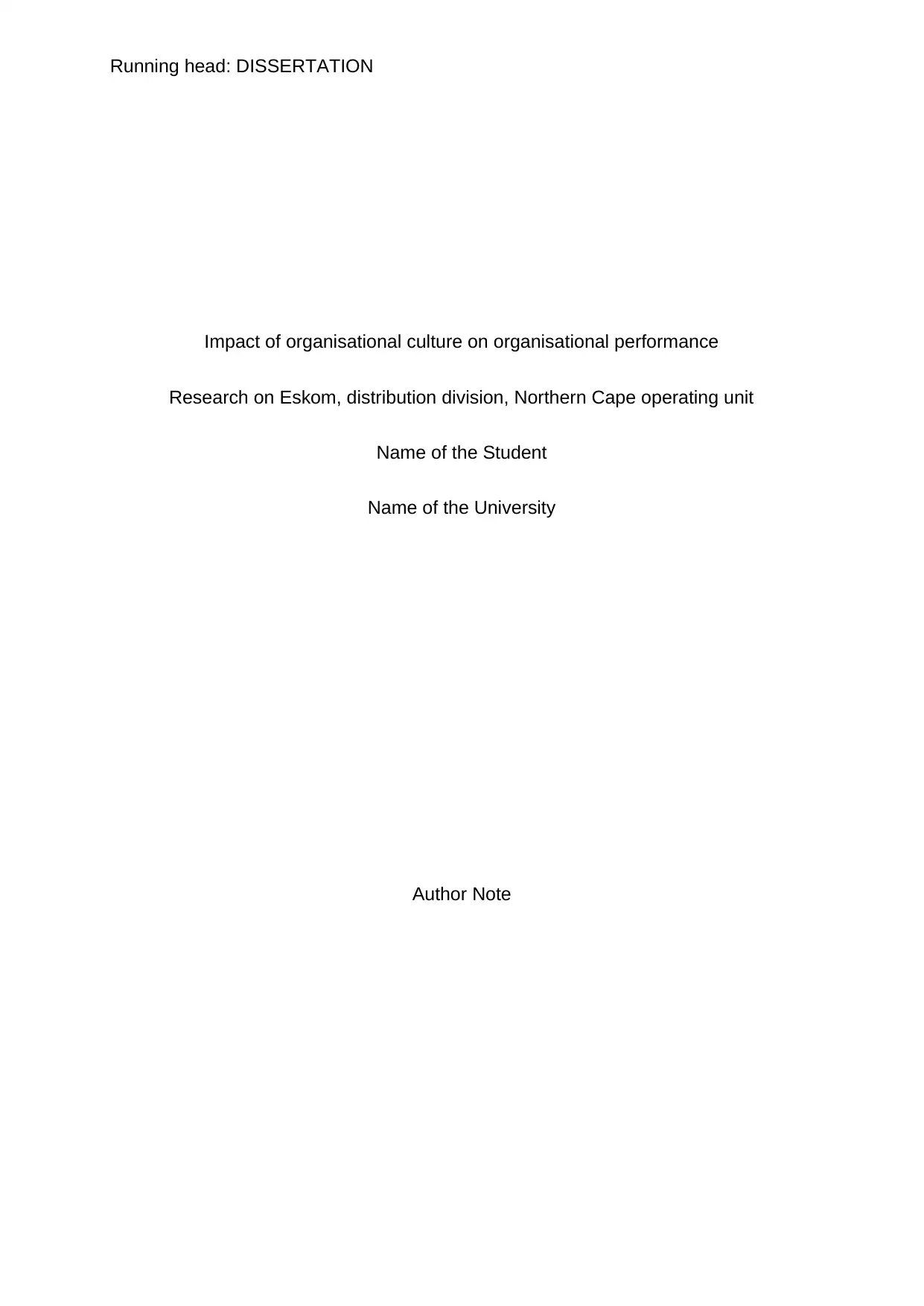
Running head: DISSERTATION
Impact of organisational culture on organisational performance
Research on Eskom, distribution division, Northern Cape operating unit
Name of the Student
Name of the University
Author Note
Impact of organisational culture on organisational performance
Research on Eskom, distribution division, Northern Cape operating unit
Name of the Student
Name of the University
Author Note
Paraphrase This Document
Need a fresh take? Get an instant paraphrase of this document with our AI Paraphraser
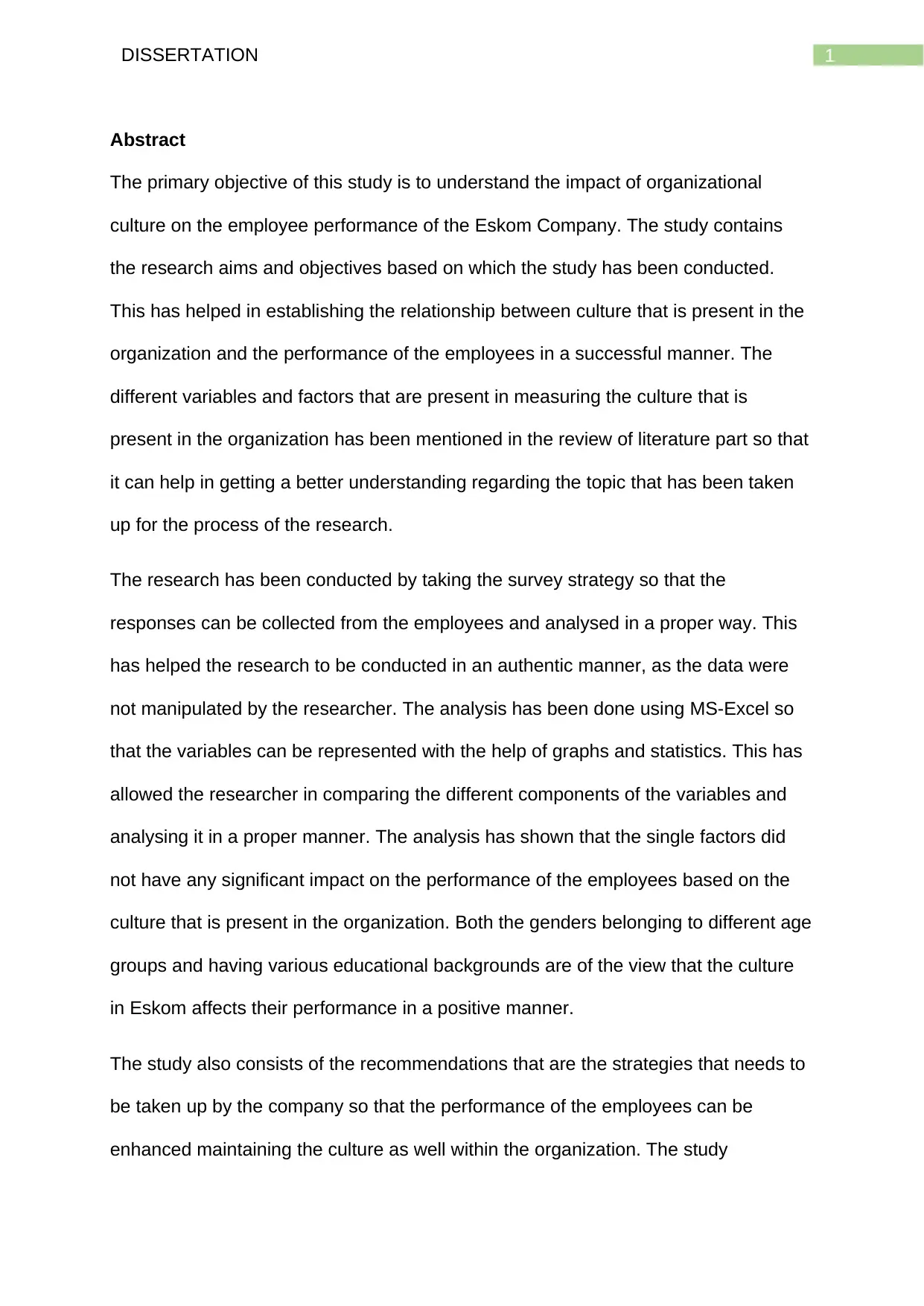
1DISSERTATION
Abstract
The primary objective of this study is to understand the impact of organizational
culture on the employee performance of the Eskom Company. The study contains
the research aims and objectives based on which the study has been conducted.
This has helped in establishing the relationship between culture that is present in the
organization and the performance of the employees in a successful manner. The
different variables and factors that are present in measuring the culture that is
present in the organization has been mentioned in the review of literature part so that
it can help in getting a better understanding regarding the topic that has been taken
up for the process of the research.
The research has been conducted by taking the survey strategy so that the
responses can be collected from the employees and analysed in a proper way. This
has helped the research to be conducted in an authentic manner, as the data were
not manipulated by the researcher. The analysis has been done using MS-Excel so
that the variables can be represented with the help of graphs and statistics. This has
allowed the researcher in comparing the different components of the variables and
analysing it in a proper manner. The analysis has shown that the single factors did
not have any significant impact on the performance of the employees based on the
culture that is present in the organization. Both the genders belonging to different age
groups and having various educational backgrounds are of the view that the culture
in Eskom affects their performance in a positive manner.
The study also consists of the recommendations that are the strategies that needs to
be taken up by the company so that the performance of the employees can be
enhanced maintaining the culture as well within the organization. The study
Abstract
The primary objective of this study is to understand the impact of organizational
culture on the employee performance of the Eskom Company. The study contains
the research aims and objectives based on which the study has been conducted.
This has helped in establishing the relationship between culture that is present in the
organization and the performance of the employees in a successful manner. The
different variables and factors that are present in measuring the culture that is
present in the organization has been mentioned in the review of literature part so that
it can help in getting a better understanding regarding the topic that has been taken
up for the process of the research.
The research has been conducted by taking the survey strategy so that the
responses can be collected from the employees and analysed in a proper way. This
has helped the research to be conducted in an authentic manner, as the data were
not manipulated by the researcher. The analysis has been done using MS-Excel so
that the variables can be represented with the help of graphs and statistics. This has
allowed the researcher in comparing the different components of the variables and
analysing it in a proper manner. The analysis has shown that the single factors did
not have any significant impact on the performance of the employees based on the
culture that is present in the organization. Both the genders belonging to different age
groups and having various educational backgrounds are of the view that the culture
in Eskom affects their performance in a positive manner.
The study also consists of the recommendations that are the strategies that needs to
be taken up by the company so that the performance of the employees can be
enhanced maintaining the culture as well within the organization. The study

2DISSERTATION
concludes that the internal business procedures along with the customer services
need to be enhanced so that it can allow the company in gaining a competitive
advantage in the market.
concludes that the internal business procedures along with the customer services
need to be enhanced so that it can allow the company in gaining a competitive
advantage in the market.
⊘ This is a preview!⊘
Do you want full access?
Subscribe today to unlock all pages.

Trusted by 1+ million students worldwide
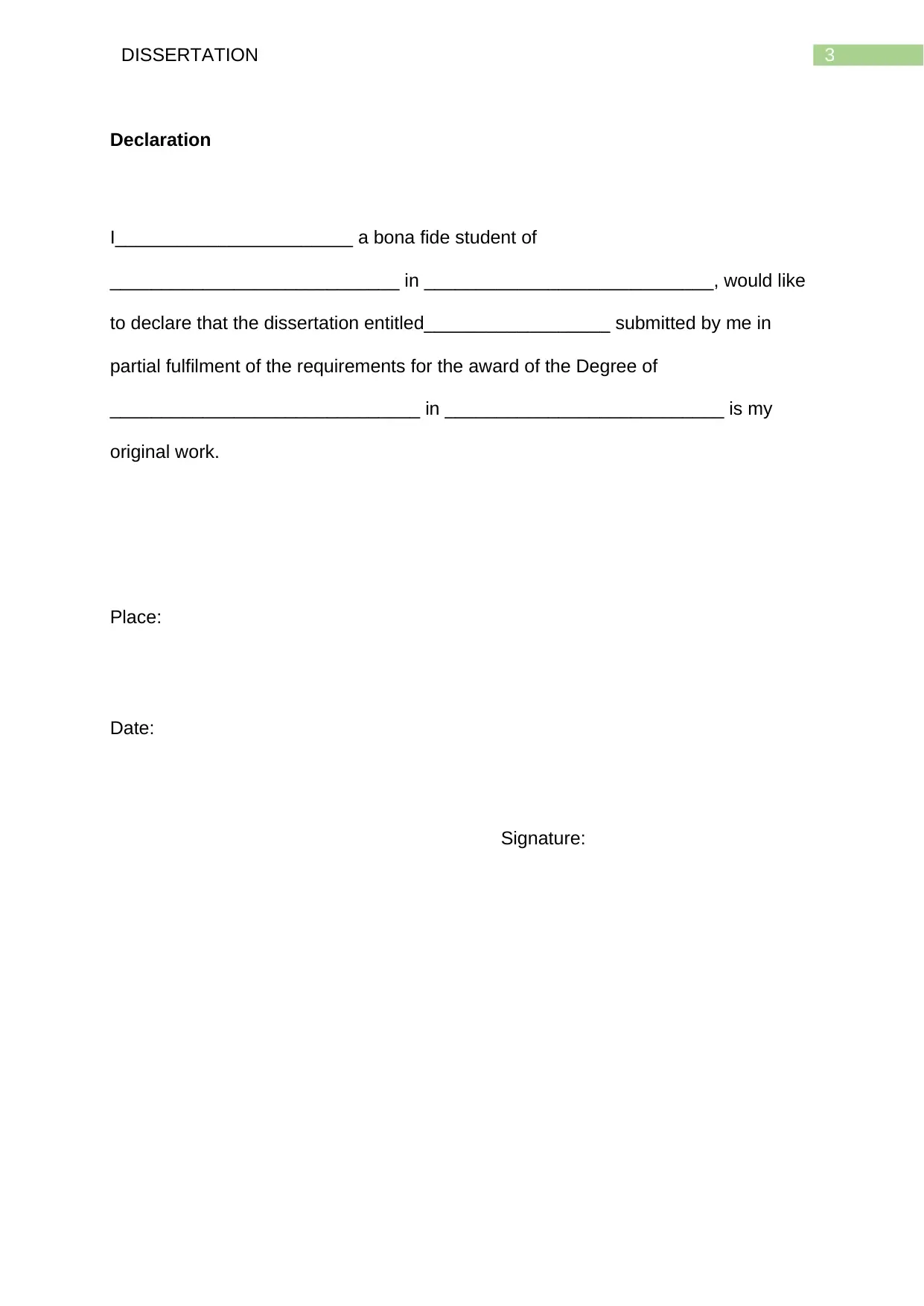
3DISSERTATION
Declaration
I_______________________ a bona fide student of
____________________________ in ____________________________, would like
to declare that the dissertation entitled__________________ submitted by me in
partial fulfilment of the requirements for the award of the Degree of
______________________________ in ___________________________ is my
original work.
Place:
Date:
Signature:
Declaration
I_______________________ a bona fide student of
____________________________ in ____________________________, would like
to declare that the dissertation entitled__________________ submitted by me in
partial fulfilment of the requirements for the award of the Degree of
______________________________ in ___________________________ is my
original work.
Place:
Date:
Signature:
Paraphrase This Document
Need a fresh take? Get an instant paraphrase of this document with our AI Paraphraser
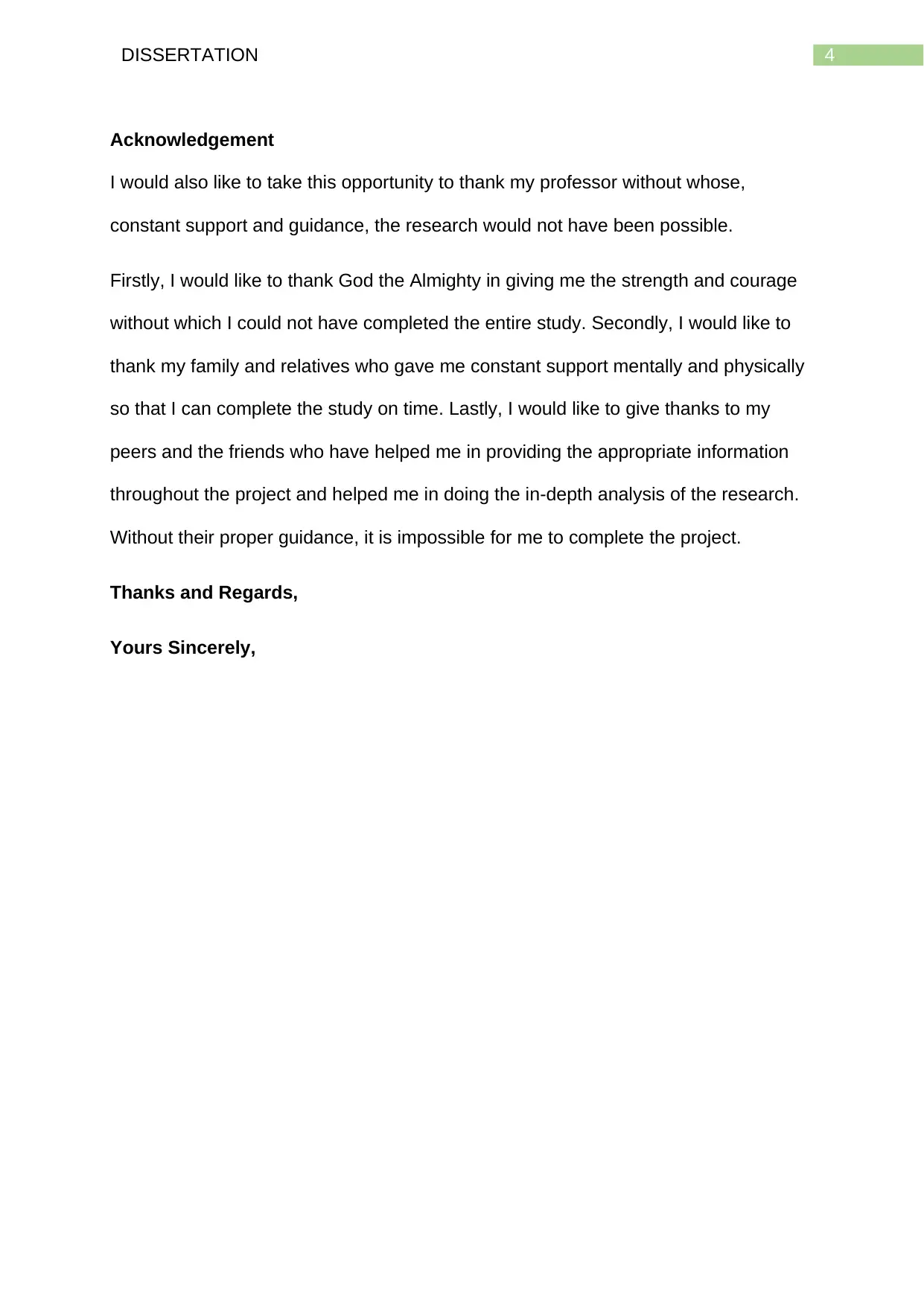
4DISSERTATION
Acknowledgement
I would also like to take this opportunity to thank my professor without whose,
constant support and guidance, the research would not have been possible.
Firstly, I would like to thank God the Almighty in giving me the strength and courage
without which I could not have completed the entire study. Secondly, I would like to
thank my family and relatives who gave me constant support mentally and physically
so that I can complete the study on time. Lastly, I would like to give thanks to my
peers and the friends who have helped me in providing the appropriate information
throughout the project and helped me in doing the in-depth analysis of the research.
Without their proper guidance, it is impossible for me to complete the project.
Thanks and Regards,
Yours Sincerely,
Acknowledgement
I would also like to take this opportunity to thank my professor without whose,
constant support and guidance, the research would not have been possible.
Firstly, I would like to thank God the Almighty in giving me the strength and courage
without which I could not have completed the entire study. Secondly, I would like to
thank my family and relatives who gave me constant support mentally and physically
so that I can complete the study on time. Lastly, I would like to give thanks to my
peers and the friends who have helped me in providing the appropriate information
throughout the project and helped me in doing the in-depth analysis of the research.
Without their proper guidance, it is impossible for me to complete the project.
Thanks and Regards,
Yours Sincerely,

5DISSERTATION
Table of Contents
Chapter 1: Introduction..................................................................................................8
1.1: Background of the Study....................................................................................8
1.2: Problem Statement.............................................................................................9
1.3: Aims and objectives of the study......................................................................10
1.4: Research questions..........................................................................................11
1.5: Research hypothesis........................................................................................11
1.6: Significance of the study...................................................................................11
1.8: Structure of study..............................................................................................12
1.9: Conclusion........................................................................................................12
Chapter 2: Literature Review......................................................................................14
2.0: Definition of terms.............................................................................................14
2.1: Introduction.......................................................................................................15
2.2: Effect of organizational culture on performance...............................................15
2.3: Hofstede’s approach to organizational culture.................................................19
2.3.1: Means-oriented versus Goal-oriented measures......................................19
2.3.2: Work-oriented versus Employee-oriented.................................................20
2.3.3: Professional versus Local..........................................................................20
2.3.4: Open system versus Closed system.........................................................21
2.3.5: Strict work discipline versus Easy-going work discipline...........................21
2.3.6: Pragmatic versus Normative measures.....................................................22
2.3.7: Power Distance..........................................................................................22
Table of Contents
Chapter 1: Introduction..................................................................................................8
1.1: Background of the Study....................................................................................8
1.2: Problem Statement.............................................................................................9
1.3: Aims and objectives of the study......................................................................10
1.4: Research questions..........................................................................................11
1.5: Research hypothesis........................................................................................11
1.6: Significance of the study...................................................................................11
1.8: Structure of study..............................................................................................12
1.9: Conclusion........................................................................................................12
Chapter 2: Literature Review......................................................................................14
2.0: Definition of terms.............................................................................................14
2.1: Introduction.......................................................................................................15
2.2: Effect of organizational culture on performance...............................................15
2.3: Hofstede’s approach to organizational culture.................................................19
2.3.1: Means-oriented versus Goal-oriented measures......................................19
2.3.2: Work-oriented versus Employee-oriented.................................................20
2.3.3: Professional versus Local..........................................................................20
2.3.4: Open system versus Closed system.........................................................21
2.3.5: Strict work discipline versus Easy-going work discipline...........................21
2.3.6: Pragmatic versus Normative measures.....................................................22
2.3.7: Power Distance..........................................................................................22
⊘ This is a preview!⊘
Do you want full access?
Subscribe today to unlock all pages.

Trusted by 1+ million students worldwide

6DISSERTATION
2.3.8: Individualism versus Collectivism..............................................................22
2.3.9: Masculinity/Feminity...................................................................................22
2.3.10: Uncertainty Avoidance.............................................................................23
2.4: 3-Dimensional review of organizational culture................................................23
2.5: Effect of organizational culture on customer service........................................24
2.5.1: Reliability....................................................................................................25
2.5.2: Responsiveness.........................................................................................25
2.5.3: Assurance..................................................................................................26
2.5.4: Tangibility...................................................................................................26
2.5.5: Theory of Service-Profit Chain...................................................................27
2.6: Effect of organizational culture on the internal business system.....................29
2.7: Communication, performance and organizational culture................................32
2.8: Factors affecting organizational culture............................................................33
2.9: Conclusion........................................................................................................35
Chapter 3: Research Methodology.............................................................................36
3.1: Introduction.......................................................................................................36
3.2: Research Outline..............................................................................................36
3.3: Research philosophy........................................................................................37
3.3.1: Justification................................................................................................37
3.4: Research approach..........................................................................................38
3.4.1: Justification................................................................................................39
3.5: Research design...............................................................................................39
2.3.8: Individualism versus Collectivism..............................................................22
2.3.9: Masculinity/Feminity...................................................................................22
2.3.10: Uncertainty Avoidance.............................................................................23
2.4: 3-Dimensional review of organizational culture................................................23
2.5: Effect of organizational culture on customer service........................................24
2.5.1: Reliability....................................................................................................25
2.5.2: Responsiveness.........................................................................................25
2.5.3: Assurance..................................................................................................26
2.5.4: Tangibility...................................................................................................26
2.5.5: Theory of Service-Profit Chain...................................................................27
2.6: Effect of organizational culture on the internal business system.....................29
2.7: Communication, performance and organizational culture................................32
2.8: Factors affecting organizational culture............................................................33
2.9: Conclusion........................................................................................................35
Chapter 3: Research Methodology.............................................................................36
3.1: Introduction.......................................................................................................36
3.2: Research Outline..............................................................................................36
3.3: Research philosophy........................................................................................37
3.3.1: Justification................................................................................................37
3.4: Research approach..........................................................................................38
3.4.1: Justification................................................................................................39
3.5: Research design...............................................................................................39
Paraphrase This Document
Need a fresh take? Get an instant paraphrase of this document with our AI Paraphraser
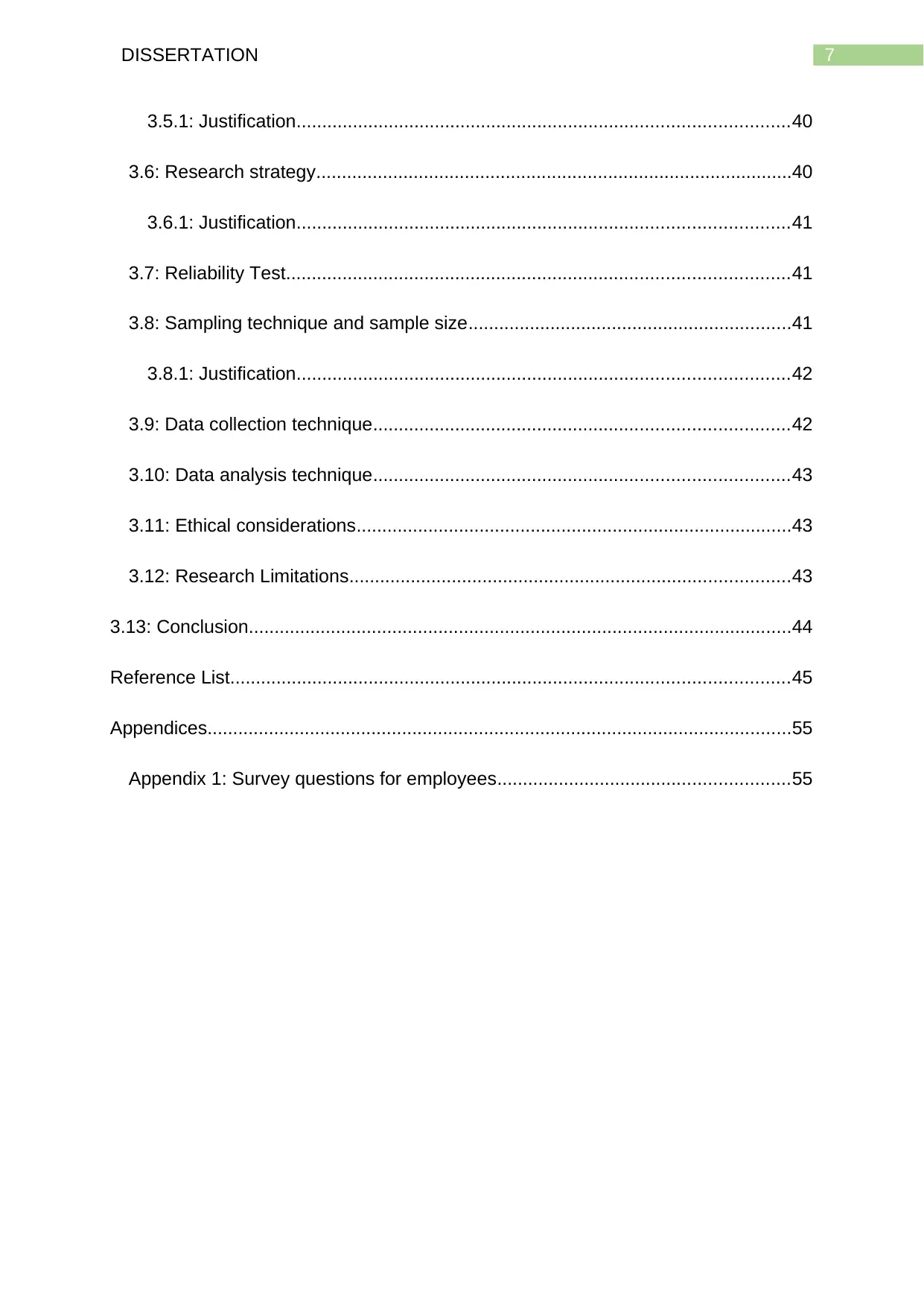
7DISSERTATION
3.5.1: Justification................................................................................................40
3.6: Research strategy.............................................................................................40
3.6.1: Justification................................................................................................41
3.7: Reliability Test..................................................................................................41
3.8: Sampling technique and sample size...............................................................41
3.8.1: Justification................................................................................................42
3.9: Data collection technique.................................................................................42
3.10: Data analysis technique.................................................................................43
3.11: Ethical considerations.....................................................................................43
3.12: Research Limitations......................................................................................43
3.13: Conclusion..........................................................................................................44
Reference List.............................................................................................................45
Appendices..................................................................................................................55
Appendix 1: Survey questions for employees.........................................................55
3.5.1: Justification................................................................................................40
3.6: Research strategy.............................................................................................40
3.6.1: Justification................................................................................................41
3.7: Reliability Test..................................................................................................41
3.8: Sampling technique and sample size...............................................................41
3.8.1: Justification................................................................................................42
3.9: Data collection technique.................................................................................42
3.10: Data analysis technique.................................................................................43
3.11: Ethical considerations.....................................................................................43
3.12: Research Limitations......................................................................................43
3.13: Conclusion..........................................................................................................44
Reference List.............................................................................................................45
Appendices..................................................................................................................55
Appendix 1: Survey questions for employees.........................................................55
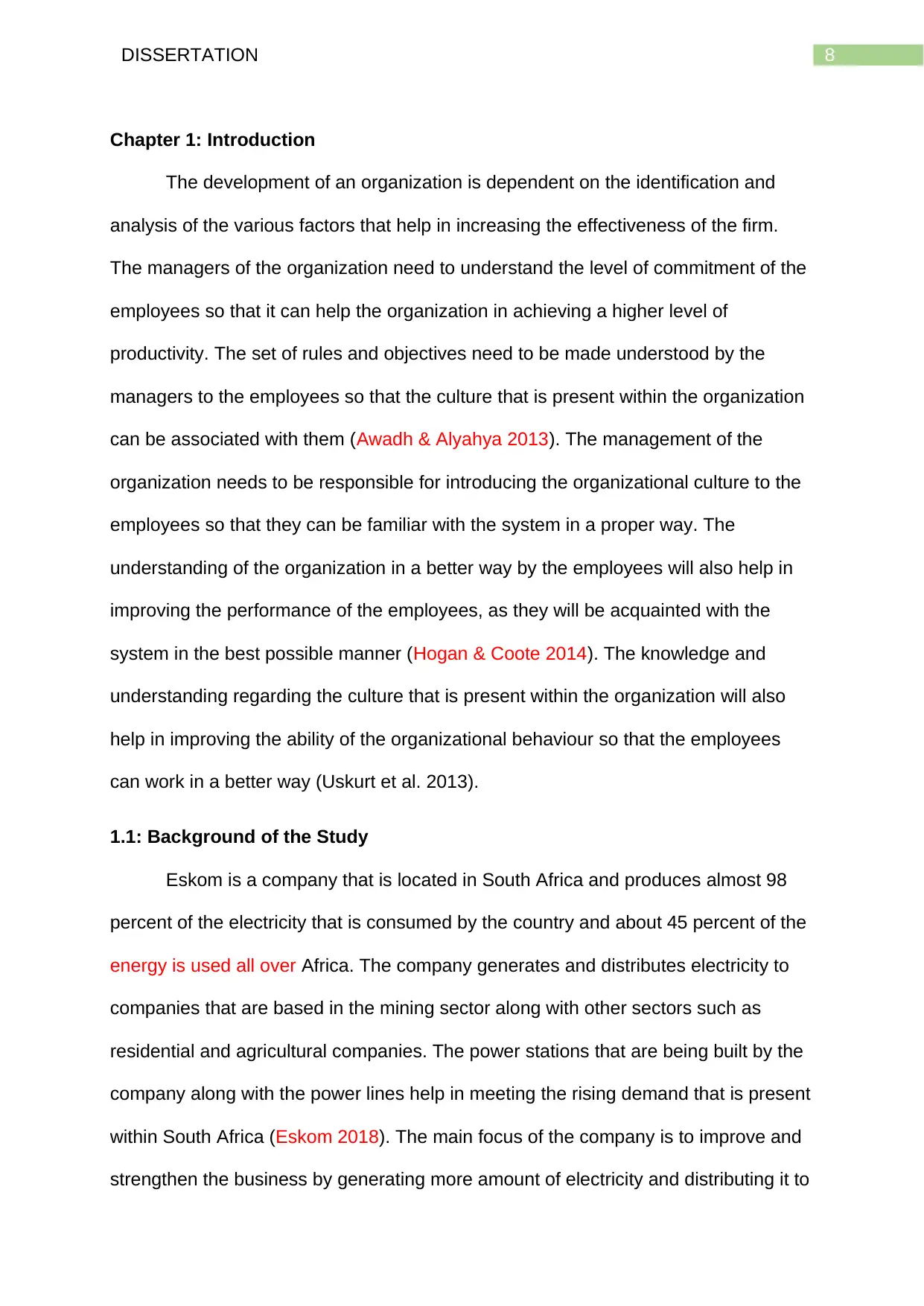
8DISSERTATION
Chapter 1: Introduction
The development of an organization is dependent on the identification and
analysis of the various factors that help in increasing the effectiveness of the firm.
The managers of the organization need to understand the level of commitment of the
employees so that it can help the organization in achieving a higher level of
productivity. The set of rules and objectives need to be made understood by the
managers to the employees so that the culture that is present within the organization
can be associated with them (Awadh & Alyahya 2013). The management of the
organization needs to be responsible for introducing the organizational culture to the
employees so that they can be familiar with the system in a proper way. The
understanding of the organization in a better way by the employees will also help in
improving the performance of the employees, as they will be acquainted with the
system in the best possible manner (Hogan & Coote 2014). The knowledge and
understanding regarding the culture that is present within the organization will also
help in improving the ability of the organizational behaviour so that the employees
can work in a better way (Uskurt et al. 2013).
1.1: Background of the Study
Eskom is a company that is located in South Africa and produces almost 98
percent of the electricity that is consumed by the country and about 45 percent of the
energy is used all over Africa. The company generates and distributes electricity to
companies that are based in the mining sector along with other sectors such as
residential and agricultural companies. The power stations that are being built by the
company along with the power lines help in meeting the rising demand that is present
within South Africa (Eskom 2018). The main focus of the company is to improve and
strengthen the business by generating more amount of electricity and distributing it to
Chapter 1: Introduction
The development of an organization is dependent on the identification and
analysis of the various factors that help in increasing the effectiveness of the firm.
The managers of the organization need to understand the level of commitment of the
employees so that it can help the organization in achieving a higher level of
productivity. The set of rules and objectives need to be made understood by the
managers to the employees so that the culture that is present within the organization
can be associated with them (Awadh & Alyahya 2013). The management of the
organization needs to be responsible for introducing the organizational culture to the
employees so that they can be familiar with the system in a proper way. The
understanding of the organization in a better way by the employees will also help in
improving the performance of the employees, as they will be acquainted with the
system in the best possible manner (Hogan & Coote 2014). The knowledge and
understanding regarding the culture that is present within the organization will also
help in improving the ability of the organizational behaviour so that the employees
can work in a better way (Uskurt et al. 2013).
1.1: Background of the Study
Eskom is a company that is located in South Africa and produces almost 98
percent of the electricity that is consumed by the country and about 45 percent of the
energy is used all over Africa. The company generates and distributes electricity to
companies that are based in the mining sector along with other sectors such as
residential and agricultural companies. The power stations that are being built by the
company along with the power lines help in meeting the rising demand that is present
within South Africa (Eskom 2018). The main focus of the company is to improve and
strengthen the business by generating more amount of electricity and distributing it to
⊘ This is a preview!⊘
Do you want full access?
Subscribe today to unlock all pages.

Trusted by 1+ million students worldwide
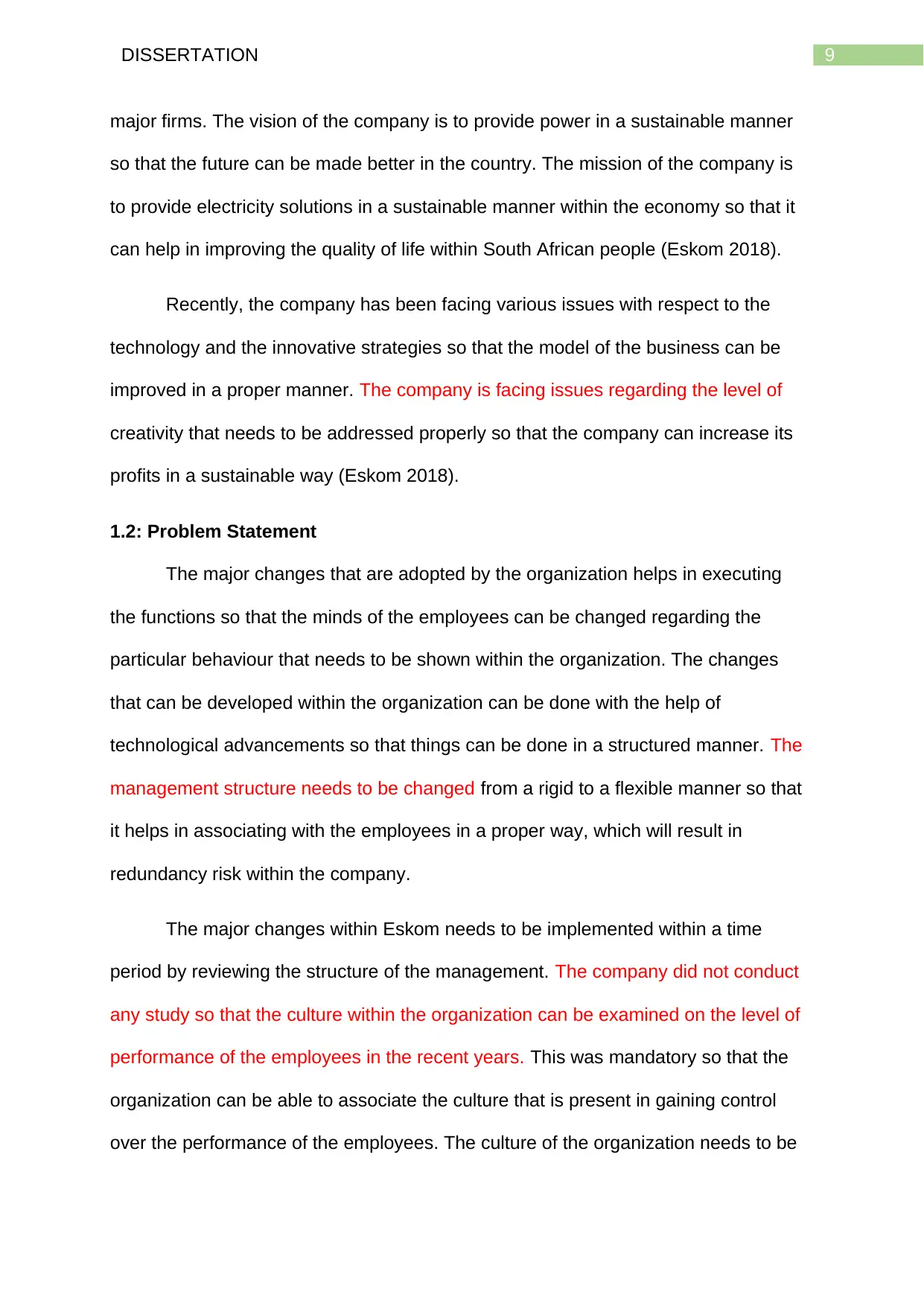
9DISSERTATION
major firms. The vision of the company is to provide power in a sustainable manner
so that the future can be made better in the country. The mission of the company is
to provide electricity solutions in a sustainable manner within the economy so that it
can help in improving the quality of life within South African people (Eskom 2018).
Recently, the company has been facing various issues with respect to the
technology and the innovative strategies so that the model of the business can be
improved in a proper manner. The company is facing issues regarding the level of
creativity that needs to be addressed properly so that the company can increase its
profits in a sustainable way (Eskom 2018).
1.2: Problem Statement
The major changes that are adopted by the organization helps in executing
the functions so that the minds of the employees can be changed regarding the
particular behaviour that needs to be shown within the organization. The changes
that can be developed within the organization can be done with the help of
technological advancements so that things can be done in a structured manner. The
management structure needs to be changed from a rigid to a flexible manner so that
it helps in associating with the employees in a proper way, which will result in
redundancy risk within the company.
The major changes within Eskom needs to be implemented within a time
period by reviewing the structure of the management. The company did not conduct
any study so that the culture within the organization can be examined on the level of
performance of the employees in the recent years. This was mandatory so that the
organization can be able to associate the culture that is present in gaining control
over the performance of the employees. The culture of the organization needs to be
major firms. The vision of the company is to provide power in a sustainable manner
so that the future can be made better in the country. The mission of the company is
to provide electricity solutions in a sustainable manner within the economy so that it
can help in improving the quality of life within South African people (Eskom 2018).
Recently, the company has been facing various issues with respect to the
technology and the innovative strategies so that the model of the business can be
improved in a proper manner. The company is facing issues regarding the level of
creativity that needs to be addressed properly so that the company can increase its
profits in a sustainable way (Eskom 2018).
1.2: Problem Statement
The major changes that are adopted by the organization helps in executing
the functions so that the minds of the employees can be changed regarding the
particular behaviour that needs to be shown within the organization. The changes
that can be developed within the organization can be done with the help of
technological advancements so that things can be done in a structured manner. The
management structure needs to be changed from a rigid to a flexible manner so that
it helps in associating with the employees in a proper way, which will result in
redundancy risk within the company.
The major changes within Eskom needs to be implemented within a time
period by reviewing the structure of the management. The company did not conduct
any study so that the culture within the organization can be examined on the level of
performance of the employees in the recent years. This was mandatory so that the
organization can be able to associate the culture that is present in gaining control
over the performance of the employees. The culture of the organization needs to be
Paraphrase This Document
Need a fresh take? Get an instant paraphrase of this document with our AI Paraphraser

10DISSERTATION
aligned with the goals and mission of the company so that the employees can
associate themselves in a better way with the culture.
The relationship between the culture and the change within the organization is
intertwined, as the performance of the employees depend mainly on the culture that
is being followed. Culture is one of the main sources that help in differentiating
between the practices that are present in performance management. The primary
reason for which this study is being conducted is that it will help in establishing the
relationship between the performance of the organization and the culture that is
present. The study will be based on Eskom so that the gaps in the company can be
addressed in a better way. It will also provide suitable recommendations to the
company in improving its culture so that the performance of the employees can be
enhanced.
1.3: Aims and objectives of the study
The main aim of the study will be to analyse the impact of organizational
culture on the organizational performance within Eskom. It will be done by identifying
the various elements that are present in organizational culture and the ways in which
it influences the performance of the organization. Additionally, in the study the gaps
that are present in the culture of the company will also be examined and suitable
recommendations has been provided. The objectives of the research will be as
follows:
To identify the current organisational culture that is found at Eskom
To identify the impact of organisational culture on the performance of the
organisation Eskom
aligned with the goals and mission of the company so that the employees can
associate themselves in a better way with the culture.
The relationship between the culture and the change within the organization is
intertwined, as the performance of the employees depend mainly on the culture that
is being followed. Culture is one of the main sources that help in differentiating
between the practices that are present in performance management. The primary
reason for which this study is being conducted is that it will help in establishing the
relationship between the performance of the organization and the culture that is
present. The study will be based on Eskom so that the gaps in the company can be
addressed in a better way. It will also provide suitable recommendations to the
company in improving its culture so that the performance of the employees can be
enhanced.
1.3: Aims and objectives of the study
The main aim of the study will be to analyse the impact of organizational
culture on the organizational performance within Eskom. It will be done by identifying
the various elements that are present in organizational culture and the ways in which
it influences the performance of the organization. Additionally, in the study the gaps
that are present in the culture of the company will also be examined and suitable
recommendations has been provided. The objectives of the research will be as
follows:
To identify the current organisational culture that is found at Eskom
To identify the impact of organisational culture on the performance of the
organisation Eskom
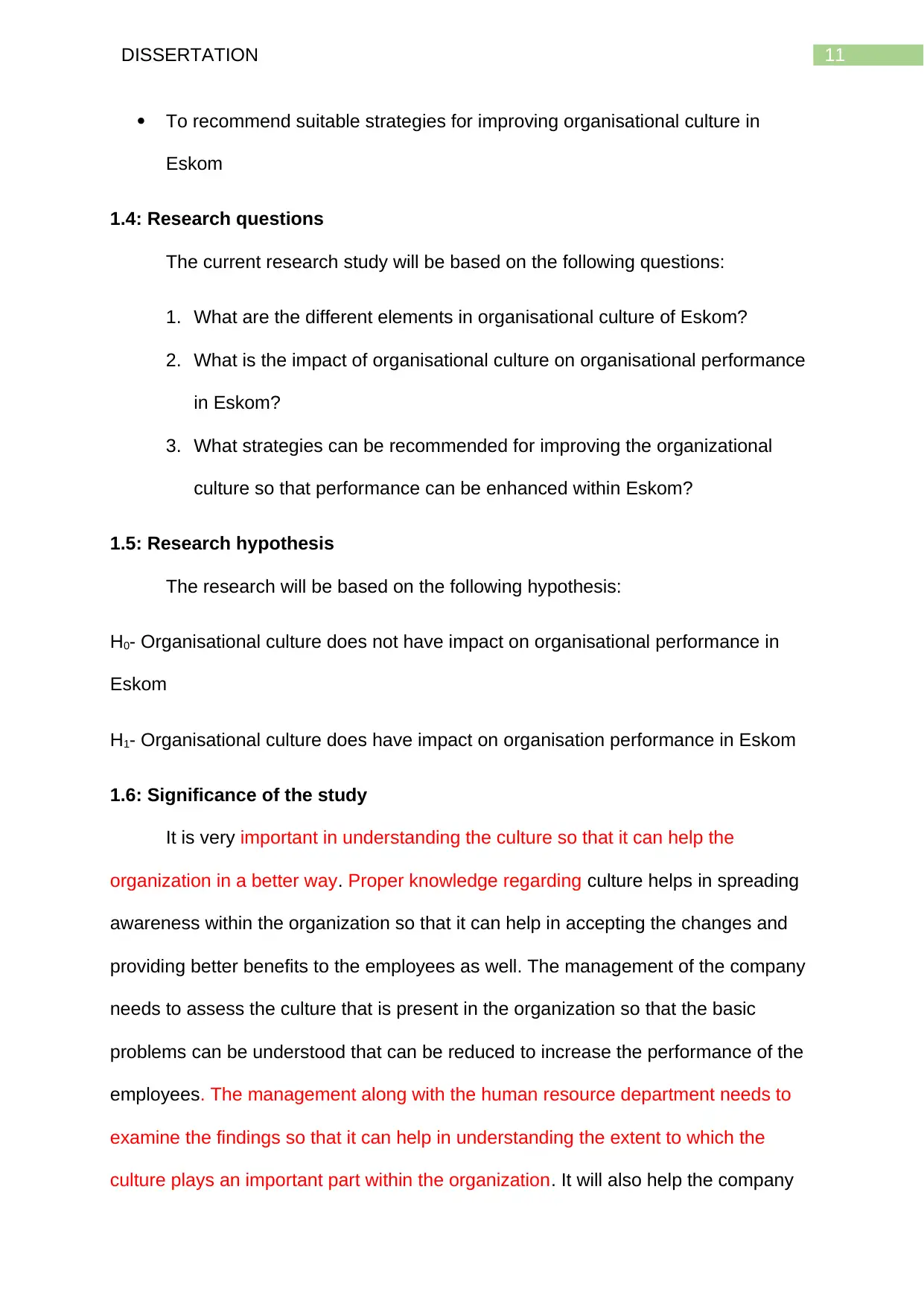
11DISSERTATION
To recommend suitable strategies for improving organisational culture in
Eskom
1.4: Research questions
The current research study will be based on the following questions:
1. What are the different elements in organisational culture of Eskom?
2. What is the impact of organisational culture on organisational performance
in Eskom?
3. What strategies can be recommended for improving the organizational
culture so that performance can be enhanced within Eskom?
1.5: Research hypothesis
The research will be based on the following hypothesis:
H0- Organisational culture does not have impact on organisational performance in
Eskom
H1- Organisational culture does have impact on organisation performance in Eskom
1.6: Significance of the study
It is very important in understanding the culture so that it can help the
organization in a better way. Proper knowledge regarding culture helps in spreading
awareness within the organization so that it can help in accepting the changes and
providing better benefits to the employees as well. The management of the company
needs to assess the culture that is present in the organization so that the basic
problems can be understood that can be reduced to increase the performance of the
employees. The management along with the human resource department needs to
examine the findings so that it can help in understanding the extent to which the
culture plays an important part within the organization. It will also help the company
To recommend suitable strategies for improving organisational culture in
Eskom
1.4: Research questions
The current research study will be based on the following questions:
1. What are the different elements in organisational culture of Eskom?
2. What is the impact of organisational culture on organisational performance
in Eskom?
3. What strategies can be recommended for improving the organizational
culture so that performance can be enhanced within Eskom?
1.5: Research hypothesis
The research will be based on the following hypothesis:
H0- Organisational culture does not have impact on organisational performance in
Eskom
H1- Organisational culture does have impact on organisation performance in Eskom
1.6: Significance of the study
It is very important in understanding the culture so that it can help the
organization in a better way. Proper knowledge regarding culture helps in spreading
awareness within the organization so that it can help in accepting the changes and
providing better benefits to the employees as well. The management of the company
needs to assess the culture that is present in the organization so that the basic
problems can be understood that can be reduced to increase the performance of the
employees. The management along with the human resource department needs to
examine the findings so that it can help in understanding the extent to which the
culture plays an important part within the organization. It will also help the company
⊘ This is a preview!⊘
Do you want full access?
Subscribe today to unlock all pages.

Trusted by 1+ million students worldwide
1 out of 60
Related Documents
Your All-in-One AI-Powered Toolkit for Academic Success.
+13062052269
info@desklib.com
Available 24*7 on WhatsApp / Email
![[object Object]](/_next/static/media/star-bottom.7253800d.svg)
Unlock your academic potential
Copyright © 2020–2025 A2Z Services. All Rights Reserved. Developed and managed by ZUCOL.





